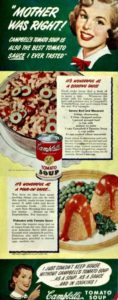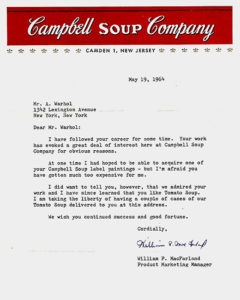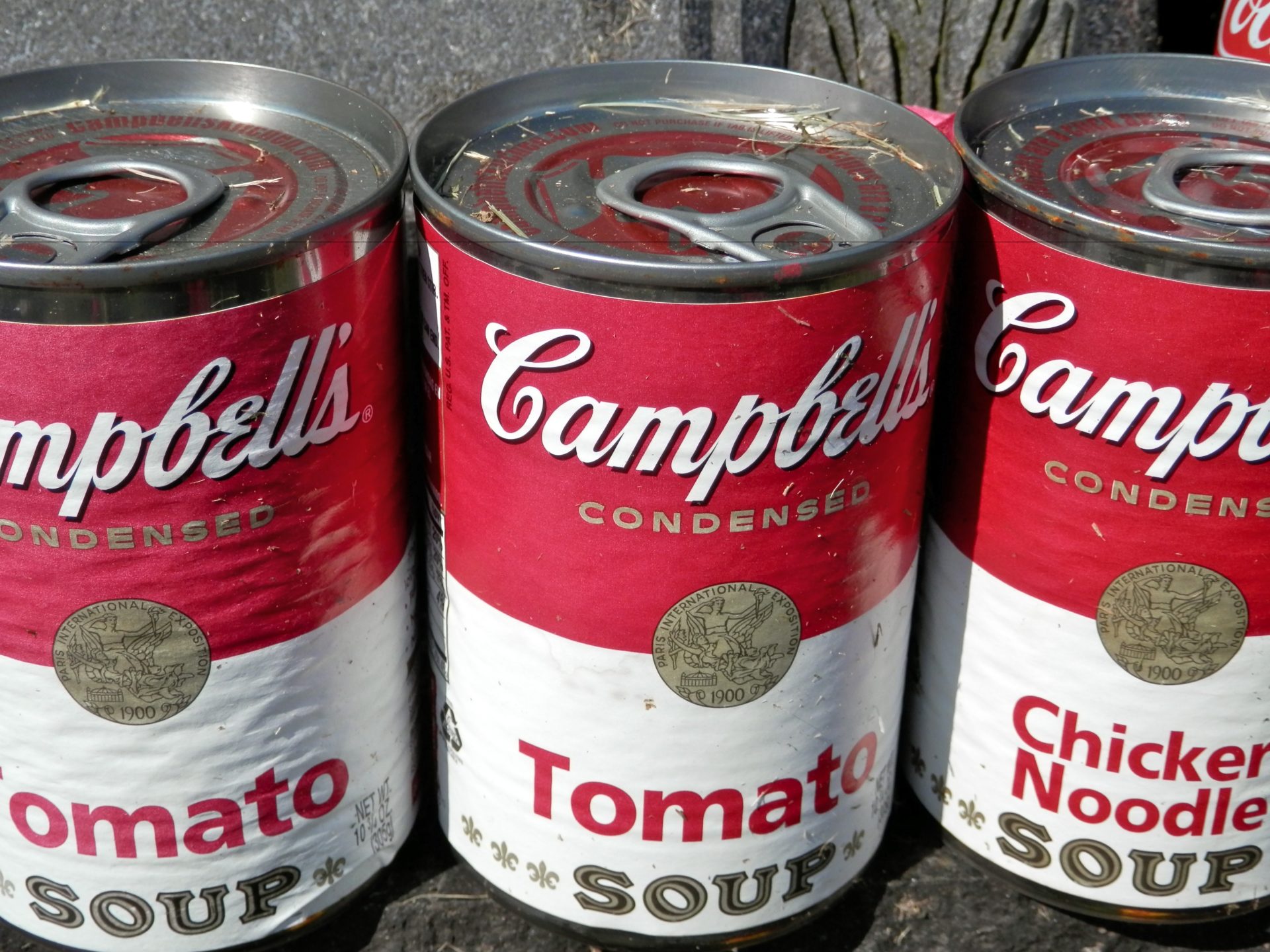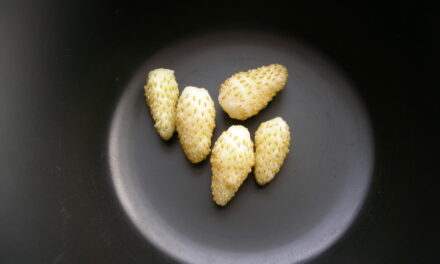
Tomato Soup, by Andy Warhol 1962
In 1962, a Pittsburgh based commercial illustrator and graphic designer named Andy Warhol had his first solo art exhibition. It was a collection of 32 nearly identical silkscreen images, all 16×20 inches, and each one depicting a can of Campbell’s Soup.
The only difference between the paintings was the flavour on the label: Black Bean, Onion, Clam Chowder, Chicken, Pepper Pot, and of course, Tomato.
Hard to imagine a time that Warhol was not synonymous with Pop Art. This moment was not the true birth of pop art, which had been flourishing conceptually in both America and abroad for over a decade. But in our memory, it is the iconic beginning nonetheless. The term “pop art” was officially coined later that year at the Museum of Modern Art. The world was soon saturated in Warhol, and of course, soup.
Another gallery director, Muriel Latow, had been talking with Andy about his art. She encouraged him to create work from, “Something you see every day and something that everybody would recognize. Something like a can of Campbell’s Soup.”
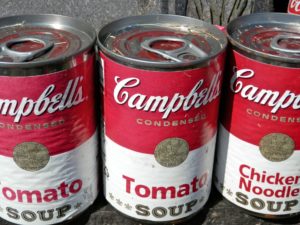
Andy Warhol’s Grave, photo by Lorette C. Luzajic
The rest is history, as they say. If anyone asked, Andy said he loved tomato soup. “I was given the same food for twenty years: soup and sandwiches. And I can tell you, my favourite is Campbell’s Tomato Soup.” Elsewhere, he told the same story. “I used to drink it. I used to have the same lunch every day, for twenty years, I guess, the same thing over and over.”His peers concurred. Artist Robert Indiana said, “I knew Andy very well. The reason he painted soup cans is that he liked soup.”
Campbell’s invented canned tomato soup in 1895. In 1897, a chemist at the company suggested eliminating water from the recipes, greatly reducing the volume and weight of the products, allowing a mass affordability on shelves and in shipping. Condensed, canned tomato soup was born.
Campbell’s recipe includes water, tomato paste, sugar, flour, salt, soybean or canola oil, citric acid, flavours, and spices. The company sells around 85 million cans of the red stuff every year.
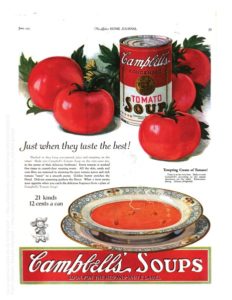
Ad from 1923.
It is highly unlikely that Warhol grew up on Campbell’s, however. The famous tomato giant in his neck of the woods, Pittsburgh, was Heinz. Heinz tomato soup was not far behind, launching in 1910. Heinz was already by that era famous for its “catsup.” Andy claimed their childhood version of tomato soup was actually ketchup, salt, pepper and water. The Warhols were dirt poor immigrants from Europe’s Carpathian mountains, speaking a language few knew called Rusyn. Dad was a coal miner and steel mill labourer but died in an accident when Warhol was a boy. Mom also made her own tomato soup from the garden, using whatever other vegetables she could grow as well. It was cheaper and more nourishing than the fabled Andy brand.
Of course, neither competing convenience food brand invented tomato soup!
The oldest known cookbook mention of tomato soup was in 1857, in Miss Leslie’s New Cookery Book, published by T.B. Peterson and Brothers. (You can get a free ebook copy here.)

The second mention we are aware of was in 1872 in The Appledore Cook Book by Maria Parloa. (You can get a reprint from Amazon here.)
Both of these recipes could more aptly be called Tomato Beef Soup. While this version was definitely more hearty and nutritious, if there was a recipe more closely resembling the creamy, bland simplicity we think of when we hear the words “tomato soup,” you had to go across the ocean to Poland.
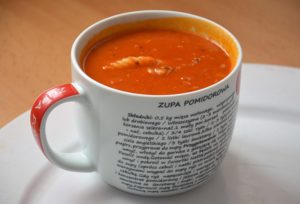
There is some debate over the origins of zupa pomidorowa, sometimes known as “Monday Soup.” Many zealous enthusiasts insist it is a 500 year old tradition, dating from the post-Dracula days of Transylvania when the Bathorys ruled. Perhaps. As we shall see, tomatoes landed in Europe around that time, but were mostly decorative and believed to be poisonous. Tomato soup is more likely relatively modern in Polish cooking.
Soup is the starter for most Polish meals, and tomato soup is a massively popular comfort food. For purists, Monday Soup is made of only three ingredients: chicken soup leftover from Sunday, pureed tomatoes, and cream. The chicken broth of course will have been made with onions, carrots, and garden herbs, so you’ll see “from scratch” recipes with vegetables, parsley, etc. Most households have a preference of adding either egg noodles or rice to the zupa pomidorowa.
While the delicious, nutritious and rich Polish zupa tastes more close to home, it contends with the Spanish tradition of gazpacho for currently known original of tomato soup. Gazpacho is basically a cold vegetable soup, not something commonly consumed here but popular across Spain, Portugal and the Mediterranean. However, though gazpacho has been around for centuries, it was not synonymous with tomatoes until the 1900s. While typically pureed or partially pureed, today’s gazpacho is likely influenced by the “new world” and much older version of cold and liquidy tomato and vegetable cuisine, otherwise known as salsa.
It may also surprise many that tomato soup and tomato sauce were not an ancient part of Italy’s culinary heritage. Tomatoes are a new kid on Italy’s block. For the beloved tomato, as with so many favourites, we have Mexico to thank. Wild tomato varieties are native to Mexico and South and Central America. The Aztecs domesticated the Solanum lycopersicum into the edible and abundant tomato. Xictomatl and tomatl (red and green tomatoes) are Nahuatl (the Aztec language) words!
Friar and priest Bernardino de Sahagun observed and wrote about tomatoes in the markets in Tenochtitlan (Mexico City), brimming with “. . . large tomatoes, small tomatoes, leaf tomatoes, sweet tomatoes, large serpent tomatoes, nipple-shaped tomatoes…” He noted sauces and stews made from tomatoes: “foods sauces, hot sauces…with tomatoes…sauce of large tomatoes, sauce of ordinary tomatoes…”
It would make sense to assume that the seeds were immediately taken back to Spain and Europe like so much else the Spaniards helped themselves to, and that is true. The first known transfer of the tomato was by Hernan Cortes himself in 1521. The tomato was easy to cultivate in the Mediterranean climate.

Oldest known preserved tomato plants in Europe.
But the plants were considered more as decoration and the tomatl took a long time to catch on as a popular superfood. The Spanish and Italians began slowly and reluctantly using the plant as food in the 1500s. But they were mostly viewed as ornamental fruits for tabletops and gardens. It is true that some varieties are poisonous, but those aren’t the kind we eat. And it is also true that solanine, a naturally occurring phytochemical in tomatoes, peppers, and eggplants, can be inflammatory to some arthritis sufferers. But the “poison apples,” as tomatoes were fearfully named by Europeans, were not to blame for the rash of adverse reactions and deaths among aristocrats who ate them: it was the fruit’s acid on the lead-heavy pewter platters that were popular at the time.
Tomato sauce or soup started to make Italian culinary appearances in the late 17th century, with first known mention in Lo scalco alla moderna, a 1692 cookbook by Antonio Latini. The first known use with pasta, as Italy is now famous for, wasn’t until 1790, in Francesco Leonardi’s L’Apicio modern. The thrilling spectrum of pasta sauces today include pasta al pomodora, puttanesca, Bolognese, and arrabiatta, but this didn’t really become a thing until the late 19th century, along with the sauce’s use in pizza. This coincided with massive Italian immigration to America and Canada. The tomato was supremely popular among Italian Americans, and families took their enthusiasm back home with them when they visited.
Italians definitely favour sauce for pizza and pasta over just zuppa when it comes to tomatoes. Their tomato soup is minestrone, a rustic or “cucina povera” (“peasant kitchen”) classic. Minestrone dates back two millennia or longer, but simply meant “serving a medley of vegetables.” It didn’t commonly feature tomatoes until the late 1800s, and does not depend on them today.
All of this means that tracing the exact date of the first tomato soup is tricky business, but our best bet is to believe that the Aztecs who first domesticated and cooked with the tomato should get the credit. Our intrepid friar Bernardino de Sahagun observed that the Aztecs were not only making but selling tomato stew by the time the Spanish arrived. “They sell some stews made from peppers and tomatoes,” he wrote in his 2400 page tome, The General History of Things in New Spain. “They usually put peppers, pumpkin seeds, tomatoes, green peppers, fat tomatoes, and other things that make the stew tasty.”
De Sahagun was not just a priest, but an ethnographer and historian, and his epic Florentine Codex was his life’s work. He learned Nahuatl and worked with indigenous Mexican people who illustrated and informed the massive text about everything. He laboured over it throughout his life in “New Spain,” from 1545 on. His work with the local people would be our first inkling of tomato soup, but for one lone previously known description.
We have just this one prior mention of something like tomato soup: detailed accounts of the conquest wars and Aztec rites by Spanish soldier Bernal Diaz. They mention that the barbecued legs and arms of sacrificial victims were simmered with salt, onions, and chiles in a tomato stew.
Bon appetit!
**

Tomato Soup from The Grilled Cheese Hideaway
The Best Tomato Soup in the World
The Grilled Cheese Hideaway 33 King St E, Bobcaygeon (705) 821-2137
You’ll need to go a bit further than your tin pantry to taste the world’s finest tomato soup. In true classic Americana style, sure to satisfy the discriminating demands of Warhol himself, chef Chris serves it up in Bobcaygeon with grilled cheese. With his partner Daniel, The Grilled Cheese Hideaway has become legendary in cottage country, and it is a fairly frequent destination drive for Torontonians, who venture out of town for the sole purpose of eating there.
The Grilled Cheese Hideaway names its epic sandwiches with titles such as Pop Goes the World, Reuben Tuesday, Practically Hip, and Groove is in the Heart. These are not Wonder Bread slices on either side of a Velveeta strip- they are towering affairs with foodielicious delights like whipped blue cheese, spicy honey, guacamole, homemade maple chutney, Gouda, peameal bacon, and beyond.
Kawartha region dairy, herbs, and produce shine on every plate. Gourmet soups change daily, heavenly cauldrons steaming with roasted garlic and parmesan, braised asparagus, Moroccan lentils, red pepper and ricotta.
But the star of the show is the menu’s constant, Tomato Soup. She is the only plain Jane on the menu- no fancy ingredients, just an unassuming bowl or red brew. One sip and you’re done for. It is far and away the best tomato soup ever made. Chris won’t give away his secret. “There is no secret,” he says. “It’s just regular tomato soup, done right.”
How good is it? I used to volunteer as a dishwasher when I was in Bobcaygeon, in exchange for a bottomless cup. I’m not even kidding.
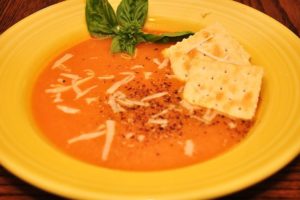
jeffreyw, CC BY 2.0 <https://creativecommons.org/licenses/by/2.0>, via Wikimedia Commons
Home Made
Click here for a bowl of comfort and local ingredients from Dairy Farmers of Canada.
The Polish Housewife helps you make a steaming bowl of Monday Soup.
A winning recipe from Prince Edward Country’s Chef Alexandra Feswick tops a classic with a twist of lemon cream. It’s easy to make at home. CBC shares her recipe.

Soup for Dessert?
Many vegetables are sublime in cupcakes: carrots, beets, zucchini, and pumpkin. But tomato soup cake?
While it might sound like a desperate marketing ploy of greedy canned brands out to lunch past lunch, weird vintage recipes for “what’s in your pantry” abounded in the 20s and 50s as a kind of post-war “cucina povera.” Home cooks had to get creative to put a cake together when supplies were scarce, and everyone had a tin of tomato soup on hand. It moistened the batter and added a bit of nutritious value to dessert.
Those days may come again with the skyrocketing rates of inflation and supply chain issues. But this weekend? No matter how you slice it, count me out.
